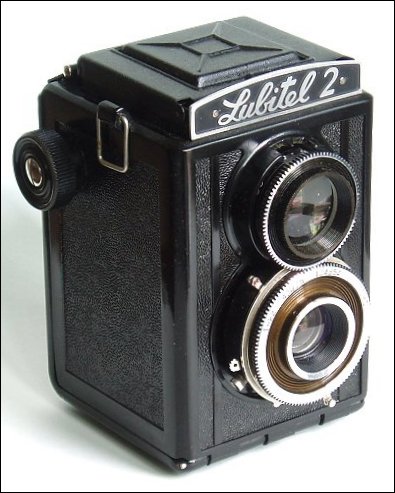
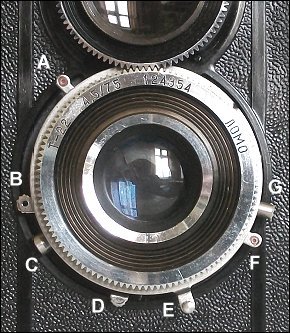
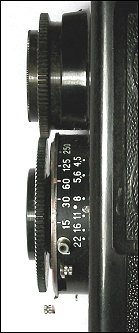
Shutter and aperture scales
Lubitel 2 taking lens showing the main controls : A Shutter cocking lever B Shutter release C Cable release socket D Aperture control lever E Shutter speed control lever F Shutter delay timing lever G Sync flash socket
This TLR (Twin Lens Reflex) 120 camera was bought brand new for a mere £6 in the mid 1970's ! Although at first sight it could be mistaken for a toy, its functionality, build and performance are truly remarkable for a camera selling at such a low price.
Manufactured in Russia between 1955 and 1980 it is of robust construction, the main body made from solid plastic (possibly bakelite). The viewing hood and lens mounts are made of metal.
The taking lens on this camera is a T-22 f4.5 with a minimum aperture of f22 and a focal length of 75mm which is a little wider than the usual 80mm standard lens for a medium format camera. The focusing arrangement is rather novel in that the taking lens is 'cogwheel-coupled' to the viewing lens as can be seen in the photographs, the viewing lens being engraved with a distance scale between 1.4 meters and infinity although focussing would normally be carried out using the viewing screen. Shutter speeds range from 1/15th sec to 1/250th sec together with a B setting.
With all the features listed above, this camera, although fiddly, is fun to use and, provided the lens is not used at maximum aperture, the images it produces are pin-sharp. Who needs a Hasselblad costing 100 times as much second-hand and giving only marginally better results ?
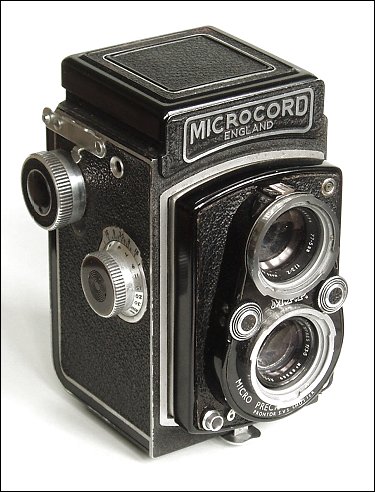
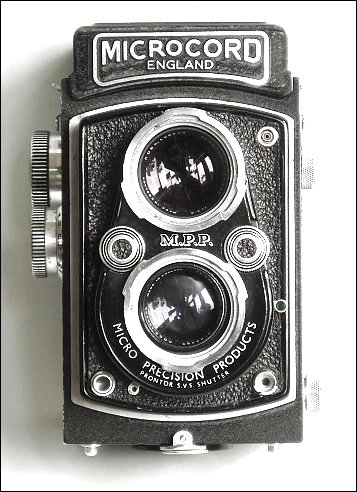
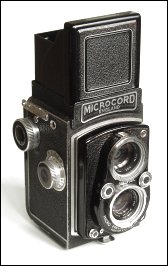
Microcord with viewing hood open
Micro Precision Products (MPP) was the only manufacturer of British TLR cameras of the post war period and were based in Kingston, Surrey. This particular model, the Microcord Mk II was made in the mid 1950's.
It is basically a copy of the Rolliecord III but fitted with Rollieflex type wheels on the front lens mount to set aperture and shutter speed, the settings being displayed in a small window on top of the viewing lens.
The taking lens is a Ross Xpres 77.5 mm f3.5 with a minimum aperture of f22. The shutter, which has to be cocked manually before released, is a Prontor SVS with speeds from 1sec to 1/300th sec together with a B setting. A shutter delay timer, cable release socket and a flash gun socket for D,X or M synchronisation also features.
The camera takes standard 120 film producing square images 2 1/4" x 2 1/4" (6 cms x 6 cms) giving 12 exposures per roll.
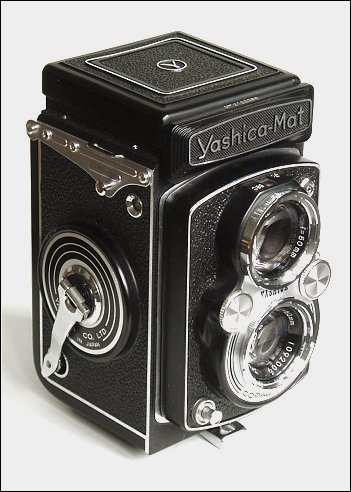

Yashica manufactured many different TLR cameras including a 4x4 format version using 127 film. This particular 6x6 model, the Yashica-Mat was introduced in 1957 and took the Rolleiflex route using an auto-stop wind lever for film transport and auto cocking shutter.
Like the Rollieflex it too uses thumbwheels on the front lens mount to adjust aperture and shutter speed, the settings being displayed in a small window on top of the viewing lens.
The taking lens is a Yashinon f3.5 with a focal length of 80mm and a minimum aperture of f22. The viewing lens has a fixed aperture of f3.2. The camera employs a Copal MVX shutter with speeds between 1 and 1/500th sec. together with B. A self timer is also featured together with a socket for either X or M flash sync.
The camera uses 120 film and produces 12 exposures 6cm x 6cm square.